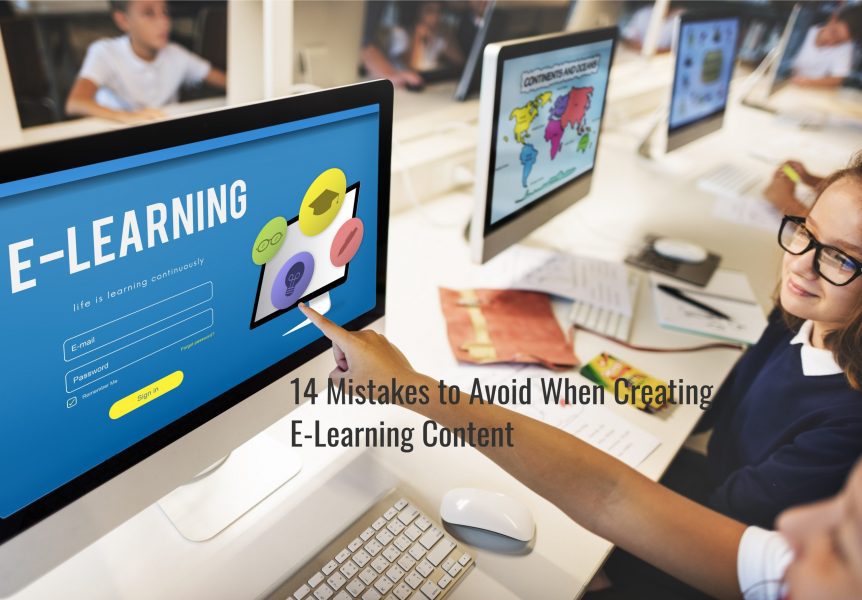14 Mistakes to Avoid When Creating E-Learning Content
Not all e-learning content is the same. Some content is better than others, with the most important metric being the value of the content to learners. In other words, does the content facilitate and help the learning experience, or does it fail to deliver both for learners and your course objectives?
Some simple mistakes can result in the latter, where the content of your e-learning course gets in the way of the learning experience. To make sure you don’t end up in this position, here are some common e-learning content mistakes to avoid.
-
Presenting an Array of Facts Without Any Learning Structure
E-learning courses should not contain fact dumps that learners then have to wade through. Instead, learners need to be brought on a journey, a journey that helps them grasp the concept or topic, or learn the skill, process, or procedure.
The way you present the content of your e-learning course should make it clear how one piece of information connects with the next and how ideas and concepts come together.
-
Assuming that Presenting a Piece of Information is Enough for Learners to Learn It
Presenting a fact, idea, or piece of information in your e-learning course once is not enough. Repetition is important in training, so you need to cover ideas in a range of different ways, seeking to reinforce and deepen understanding. Spaced repetition is one method that you can use.
-
Trying to Make Content Suitable for Too Broad a Range of Learners
Do you need to develop an e-learning course that will be completed by a broad range of individuals, i.e., people in different departments, with different educational backgrounds, with varying roles in your organisation, etc?
In these situations, a one-size-fits-all approach might not work, as the content will not have relevance for some, or even all, of the learners who will be completing the course. You will need to take a different approach, such as sub-dividing the course for different categories of learners and then tailoring the content for each sub-category.
-
Creating Content that is Too Simple
Don’t spoon-feed learners as they will become bored, uninterested, and disengaged. They also won’t learn what you need them to learn. The better approach is to stretch the people completing your course, make them think, and challenge them. They will learn the content of the course much better if you do.
-
Going Off on Tangents
It is easy to go off on tangents when creating content for e-learning courses. Tangents rarely contribute to the overall objective, and they can confuse or frustrate learners. So, the best approach is to stay focused on the main topic of the course.
If you think the tangent information could be beneficial to some learners, include it as supplementary or additional content.
-
Forgetting the Learner
Remember, the e-learning course you are creating is not about the content. It is about the learner. There is a subtle difference between the two, but that difference is what separates good content from content that is equally as good, but that also helps the learning experience.
-
Showing Off Expertise Instead of Focusing on the Objectives of the Course
Getting into unnecessary detail, using jargon, or going too high-level with e-learning content will not help learners. Instead, always focus on learners and stick to the objectives of the course.
-
Too Much Focus on Theory and Not Enough on Real-World Situations and Scenarios
The best e-learning content is content that learners can relate too. You are unlikely to achieve this with theory, but you will achieve it if you include real-world situations and scenarios to explain your points.
-
Getting too Personal or Informal with Stories, Anecdotes, Tone, and Language
It helps when e-learning content is professional but informal while also being conversational and friendly. However, it is possible to go too far, so it’s important to strike the right balance.
-
Using Humour that Could Offend Some Learners
Humour is often dangerous territory when creating content for e-learning courses. For example, humour that might work for learners in Saudi Arabia or the UAE might fall flat for learners in another country. Worse still, the humour might even offend. So, always use humour with caution.
-
Making Text Hard to Read
Examples of text that is hard to read includes:
- Text made up of stuffy, overly formal language.
- Text presented in large blocks and big paragraphs.
- Full pages of text on screen after screen after screen.
So, use conversational, everyday language as well as short sentences and short paragraphs to break up the text in your e-learning courses. Bullet point lists can help too.
-
Using Too Much Text and Not Enough Visuals
Following on from the above point, consider getting rid of some of your text altogether, replacing it with visuals.
-
Using Too Much of One Media Type
Whether it is text, images, video, or another type of media, too much is too much. Variety is the best option.
-
Publishing Without Checking for Spelling and Grammar Mistakes
Finally, always check and double-check your e-learning content for spelling and grammar mistakes. Use manual proofreading and technical tools, and don’t forget to check text in images and videos.
Creating Fantastic E-Learning Content
The type of e-learning content that will benefit your organisation and training strategy is content that strikes the right tone, that enriches the learning experience, and that helps learners grasp and retain information. Avoiding the above mistakes is a good place to start.
